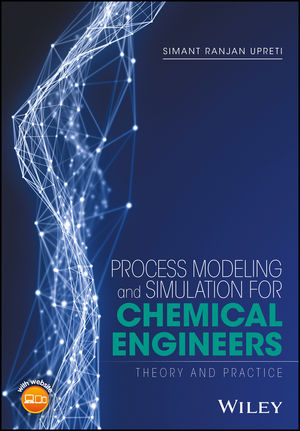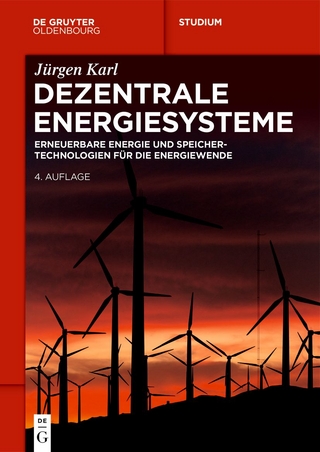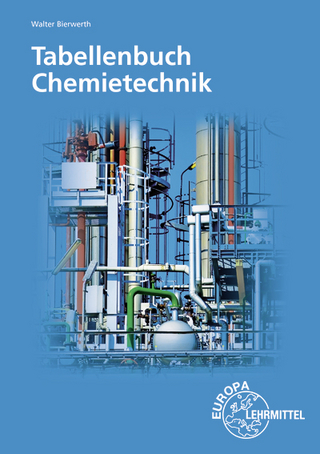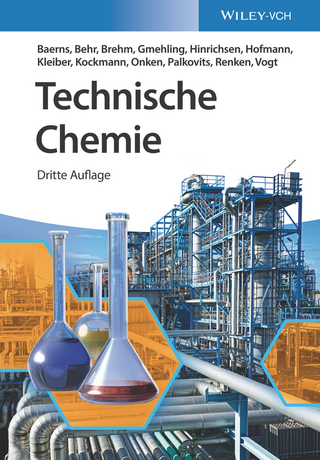
Process Modeling and Simulation for Chemical Engineers
John Wiley & Sons Inc (Verlag)
978-1-118-91468-7 (ISBN)
- Titel z.Zt. nicht lieferbar
- Versandkostenfrei innerhalb Deutschlands
- Auch auf Rechnung
- Verfügbarkeit in der Filiale vor Ort prüfen
- Artikel merken
(i) Get a solid grasp of “under-the-hood” mathematical results
(ii) Develop models of sophisticated processes
(iii) Transform models to different geometries and domains as appropriate
(iv) Utilize various model simplification techniques
(v) Learn simple and effective computational methods for model simulation
(vi) Intensify the effectiveness of their research
Modeling and Simulation for Chemical Engineers: Theory and Practice begins with an introduction to the terminology of process modeling and simulation. Chapters 2 and 3 cover fundamental and constitutive relations, while Chapter 4 on model formulation builds on these relations. Chapters 5 and 6 introduce the advanced techniques of model transformation and simplification. Chapter 7 deals with model simulation, and the final chapter reviews important mathematical concepts.
Presented in a methodical, systematic way, this book is suitable as a self-study guide or as a graduate reference, and includes examples, schematics and diagrams to enrich understanding. End of chapter problems with solutions and computer software available online at www.wiley.com/go/upreti/pms_for_chemical_engineers are designed to further stimulate readers to apply the newly learned concepts.
Simant Ranjan Upreti, Department of Chemical Engineering, Ryerson University, Toronto, Canada.
Preface xiii
Notation xv
1 Introduction 1
1.1 System 1
1.1.1 Uniform System 2
1.1.2 Properties of System 2
1.1.3 Classification of System 3
1.1.4 Model 3
1.2 Process 3
1.2.1 Classification of Processes 4
1.2.2 Process Model 5
1.3 Process Modeling 6
1.3.1 Relations 7
1.3.2 Assumptions 7
1.3.3 Variables and Parameters 8
1.4 Process Simulation 9
1.4.1 Utility 9
1.4.2 Simulation Methods 10
1.5 Development of Process Model 11
1.6 Learning about Process 13
1.7 System Specification 14
Bibliography 16
Exercises 16
2 Fundamental Relations 17
2.1 Basic Form 17
2.1.1 Application 19
2.2 Mass Balance 21
2.2.1 Microscopic Balances 21
2.2.2 Equation of Change for Mass Fraction 23
2.3 Mole Balance 24
2.3.1 Microscopic Balances 24
2.3.2 Equation of Change for Mole Fraction 25
2.4 Momentum Balance 26
2.4.1 Convective Momentum Flux 27
2.4.2 Total Momentum Flux 28
2.4.3 Macroscopic Balance 29
2.4.4 Microscopic Balance 31
2.5 Energy Balance 33
2.5.1 Microscopic Balance 33
2.5.2 Macroscopic Balance 35
2.6 Equation of Change for Kinetic and Potential Energy 38
2.6.1 Microscopic Equation 38
2.6.2 Macroscopic Equation 40
2.7 Equation of Change for Temperature 41
2.7.1 Microscopic Equation 41
2.7.2 Macroscopic Equation 42
2.A Enthalpy Change from Thermodynamics 44
2.B Divergence Theorem 48
2.C General Transport Theorem 50
2.D Equations in Cartesian, Cylindrical and Spherical Coordinate Systems 53
2.D.1 Equations of Continuity 54
2.D.2 Equations of Continuity for Individual Species 54
2.D.3 Equations of Motion 55
2.D.4 Equations of Change for Temperature 56
Bibliography 57
Exercises 57
3 Constitutive Relations 59
3.1 Diffusion 59
3.1.1 Multicomponent Mixtures 60
3.2 Viscous Motion 60
3.2.1 Newtonian Fluids 61
3.2.2 Non-Newtonian Fluids 62
3.3 Thermal Conduction 63
3.4 Chemical Reaction 63
3.5 Rate of Reaction 65
3.5.1 Equations of Change for Moles 66
3.5.2 Equations of Change for Temperature 67
3.5.3 Macroscopic Equation of Change for Temperature 69
3.6 Interphase Transfer 71
3.7 Thermodynamic Relations 72
3.A Equations in Cartesian, Cylindrical and Spherical Coordinate Systems 74
3.A.1 Equations of Continuity for Binary Systems 74
3.A.2 Equations of Motion for Newtonian Fluids 75
3.A.3 Equations of Change for Temperature 76
References 77
Bibliography 77
Exercises 78
4 Model Formulation 79
4.1 Lumped-Parameter Systems 80
4.1.1 Isothermal CSTR 80
4.1.2 Flow through Eccentric Reducer 83
4.1.3 Liquid Preheater 84
4.1.4 Non-Isothermal CSTR 87
4.2 Distributed-Parameter Systems 90
4.2.1 Nicotine Patch 90
4.2.2 Fluid Flow between Inclined Parallel Plates 93
4.2.3 Tapered Fin 96
4.2.4 Continuous Microchannel Reactor 99
4.2.5 Oxygen Transport to Tissues 103
4.2.6 Dermal Heat Transfer in Cylindrical Limb 106
4.2.7 Solvent Induced Heavy Oil Recovery 108
4.2.8 Hydrogel Tablet 112
4.2.9 Neutron Diffusion 117
4.2.10 Horton Sphere 119
4.2.11 Reactions around Solid Reactant 122
4.3 Fluxes along Non-Linear Directions 127
4.3.1 Saccadic Movement of an Eye 128
4.A Initial and Boundary Conditions 131
4.A.1 Initial Condition 131
4.A.2 Boundary Condition 131
4.A.3 Periodic Condition 132
4.B Zero Derivative at the Point of Symmetry 133
4.C Equation of Motion along the Radial Direction in Cylindrical Coordinates 134
References 137
Exercises 137
5 Model Transformation 139
5.1 Transformation between Orthogonal Coordinate Systems 139
5.1.1 Scale Factors 139
5.1.2 Differential Elements 142
5.1.3 Vector Representation 143
5.1.4 Derivatives of Unit Vectors 144
5.1.5 Differential Operators 146
5.2 Transformation between Arbitrary Coordinate Systems 155
5.2.1 Transformation of Velocity 155
5.2.2 Transformation of Spatial Derivatives 156
5.2.3 Correctness of Transformation Matrices 156
5.3 Laplace Transformation 161
5.3.1 Examples 162
5.3.2 Properties of Laplace Transforms 164
5.3.3 Solution of Linear Differential Equations 168
5.4 Miscellaneous Transformations 178
5.4.1 Higher Order Derivatives 178
5.4.2 Scaling 178
5.4.3 Change of Independent Variable 179
5.4.4 Semi-Infinite Domain 179
5.4.5 Non-Autonomous to Autonomous Differential Equation 180
5.A Differential Operators in an Orthogonal Coordinate System 180
5.A.1 Gradient of a Scalar 180
5.A.2 Divergence of a Vector 181
5.A.3 Laplacian of a Scalar 184
5.A.4 Curl of a Vector 184
References 186
Bibliography 186
Exercises 186
6 Model Simplification and Approximation 189
6.1 Model Simplification 189
6.1.1 Scaling and Ordering Analysis 190
6.1.2 Linearization 193
6.2 Model Approximation 200
6.2.1 Dimensional Analysis 201
6.2.2 Model Fitting 204
6.A Linear Function 220
6.B Proof of Buckingham Pi Theorem 221
6.C Newton's Optimization Method 223
References 224
Bibliography 224
Exercises 225
7 Process Simulation 227
7.1 Algebraic Equations 227
7.1.1 Linear Algebraic Equations 227
7.1.2 Non-Linear Algebraic Equations 236
7.2 Differential Equations 241
7.2.1 Ordinary Differential Equations 242
7.2.2 Explicit Runge–Kutta Methods 242
7.2.3 Step-Size Control 246
7.2.4 Stiff Equations 247
7.3 Partial Differential Equations 253
7.3.1 Finite Difference Method 255
7.4 Differential Equations with Split Boundaries 263
7.4.1 Shooting Newton–Raphson Method 264
7.5 Periodic Differential Equations 268
7.5.1 Shooting Newton–Raphson Method 268
7.6 Programming of Derivatives 271
7.7 Miscellanea 274
7.7.1 Integration of Discrete Data 274
7.7.2 Roots of a Single Algebraic Equation 276
7.7.3 Cubic Equations 278
7.A Partial Pivoting for Matrix Inverse 281
7.B Derivation of Newton–Raphson Method 281
7.B.1 Quadratic Convergence 282
7.C General Derivation of Finite Difference Formulas 284
7.C.1 First Derivative, Centered Second Order Formula 285
7.C.2 Second Derivative, Forward Second Order Formula 286
7.C.3 Third Derivative, Mixed Fourth Order Formula 287
7.C.4 Common Finite Difference Formulas 289
References 291
Bibliography 291
Exercises 291
8 Mathematical Review 295
8.1 Order of Magnitude 295
8.2 Big-O Notation 295
8.3 Analytical Function 295
8.4 Vectors 296
8.4.1 Vector Operations 297
8.4.2 Cauchy–Schwarz Inequality 302
8.5 Matrices 302
8.5.1 Terminology 303
8.5.2 Matrix Operations 304
8.5.3 Operator Inequality 305
8.6 Tensors 306
8.6.1 Multilinearity 306
8.6.2 Coordinate-Independence 306
8.6.3 Representation of Second Order Tensor 307
8.6.4 Einstein or Index Notation 308
8.6.5 Kronecker Delta 310
8.6.6 Operations Involving Vectors and Second Order Tensors 310
8.7 Differential 318
8.7.1 Derivative 318
8.7.2 Partial Derivative and Differential 318
8.7.3 Chain Rule of Differentiation 319
8.7.4 Material and Total Derivatives 321
8.8 Taylor Series 322
8.8.1 Multivariable Taylor Series 323
8.8.2 First Order Taylor Expansion 323
8.9 L'Hôpital's Rule 326
8.10 Leibniz's Rule 326
8.11 Integration by Parts 327
8.12 Euler’s Formulas 327
8.13 Solution of Linear Ordinary Differential Equations 327
8.13.1 Single First Order Equation 327
8.13.2 Simultaneous First Order Equations 328
Bibliography 332
Index 333
| Erscheinungsdatum | 27.04.2017 |
|---|---|
| Verlagsort | New York |
| Sprache | englisch |
| Maße | 175 x 246 mm |
| Gewicht | 703 g |
| Themenwelt | Naturwissenschaften ► Chemie ► Technische Chemie |
| Technik | |
| ISBN-10 | 1-118-91468-6 / 1118914686 |
| ISBN-13 | 978-1-118-91468-7 / 9781118914687 |
| Zustand | Neuware |
| Informationen gemäß Produktsicherheitsverordnung (GPSR) | |
| Haben Sie eine Frage zum Produkt? |
aus dem Bereich


